HI5002 Finance for Business: Financial Statement and WACC Analysis
VerifiedAdded on 2024/06/04
|12
|1724
|184
Report
AI Summary
This report provides a financial analysis of a selected company, including the calculation and interpretation of fundamental ratios such as short-term solvency, long-term solvency, asset utilization, and profitability ratios for the past two years. It features a share price analysis presented graphically, comparing it with an index, and discusses the implications of a company's weighted average cost of capital (WACC). The report also examines the company's capital structure, gearing ratios, and dividend policy, referencing the company's annual reports to support its findings. Desklib provides access to this and other solved assignments for students.
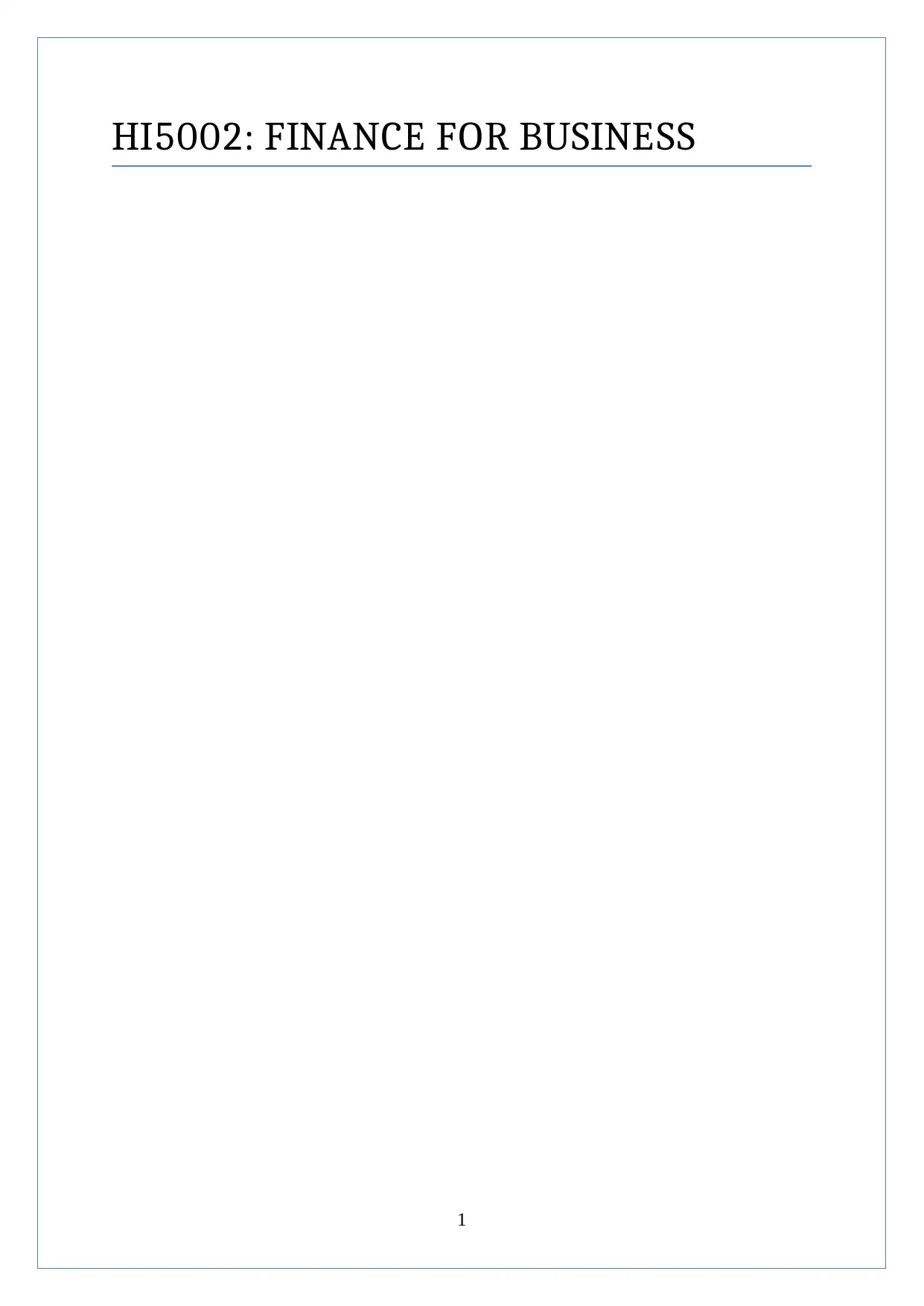
HI5002: FINANCE FOR BUSINESS
1
1
Paraphrase This Document
Need a fresh take? Get an instant paraphrase of this document with our AI Paraphraser
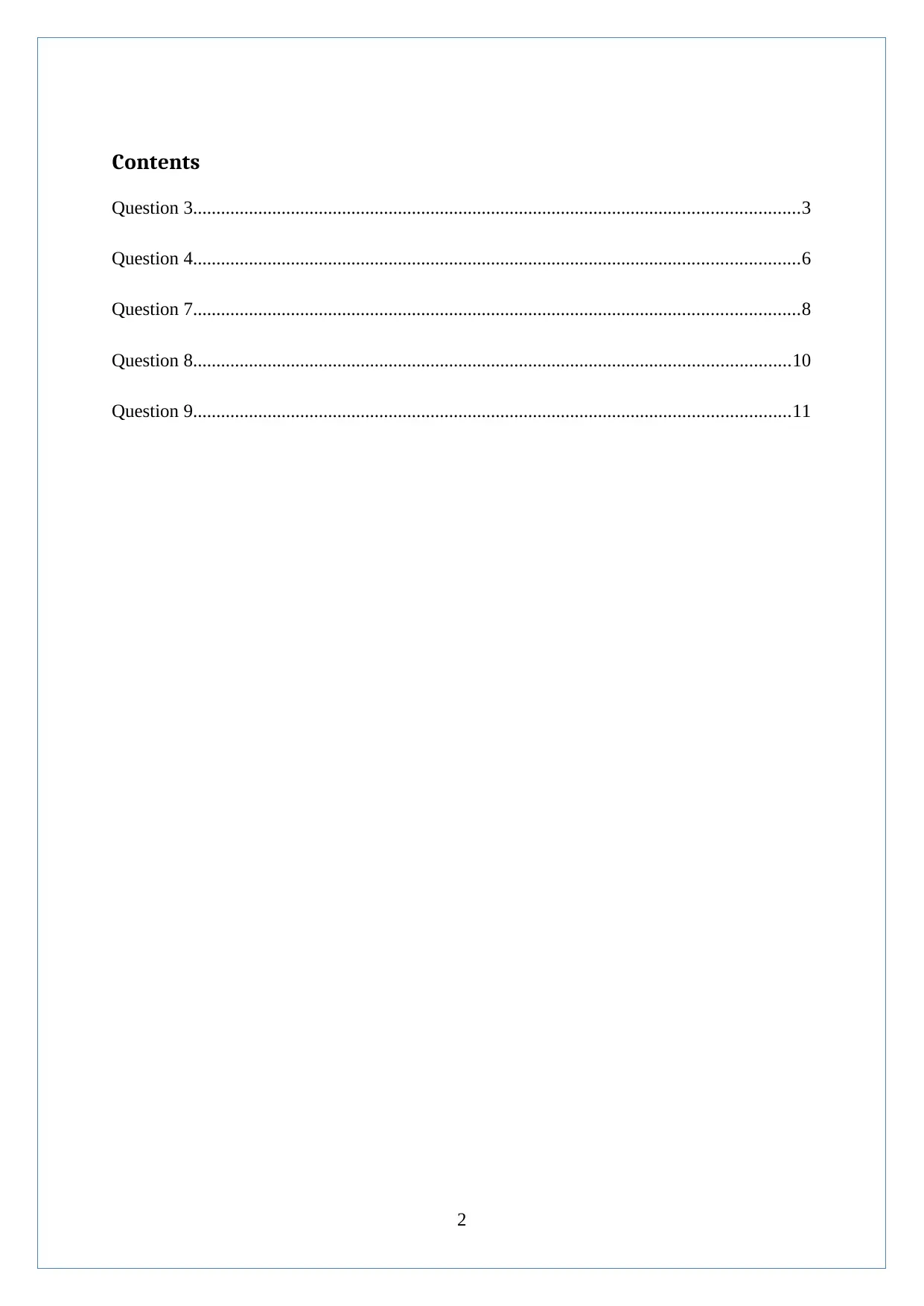
Contents
Question 3..................................................................................................................................3
Question 4..................................................................................................................................6
Question 7..................................................................................................................................8
Question 8................................................................................................................................10
Question 9................................................................................................................................11
2
Question 3..................................................................................................................................3
Question 4..................................................................................................................................6
Question 7..................................................................................................................................8
Question 8................................................................................................................................10
Question 9................................................................................................................................11
2
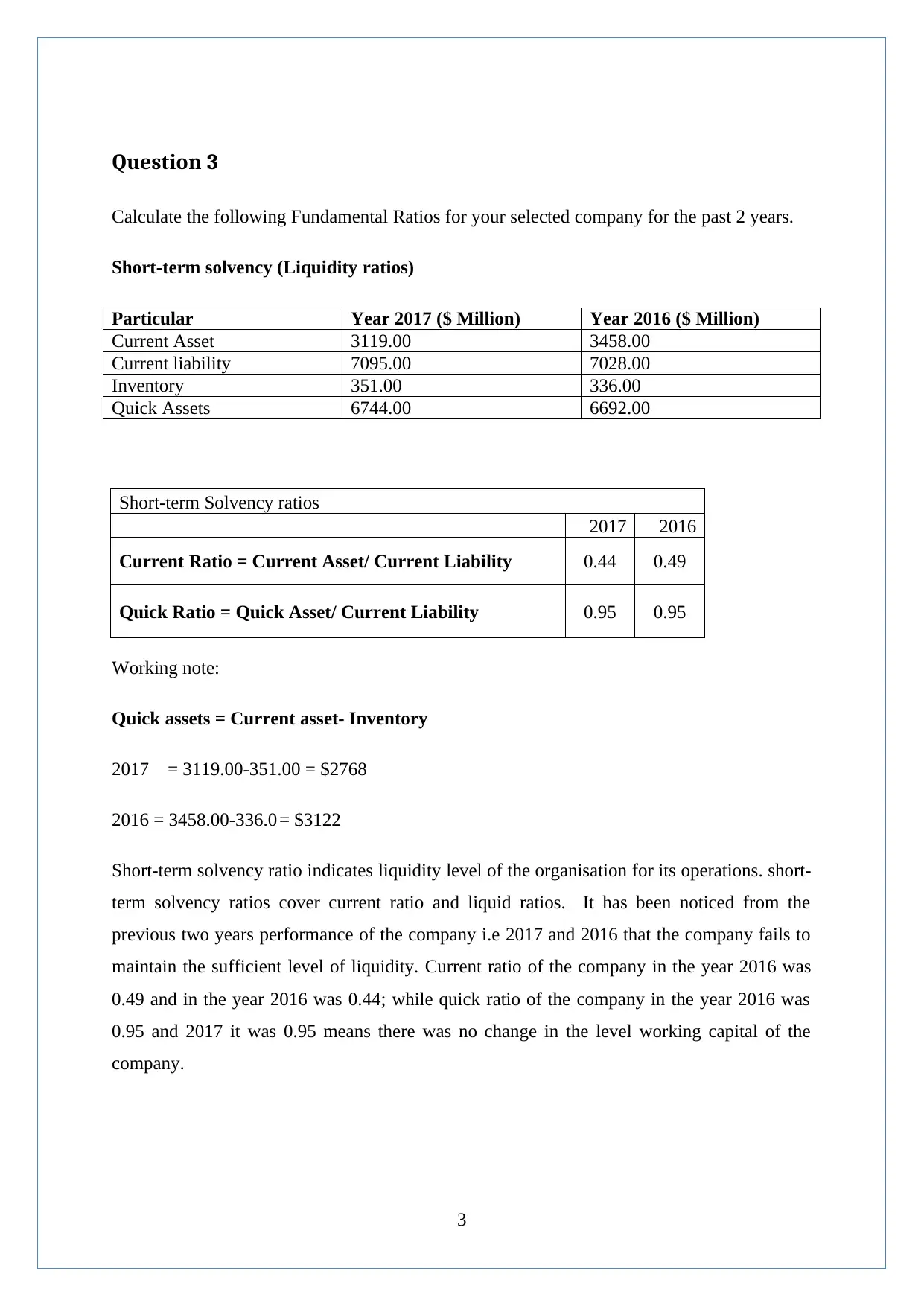
Question 3
Calculate the following Fundamental Ratios for your selected company for the past 2 years.
Short-term solvency (Liquidity ratios)
Particular Year 2017 ($ Million) Year 2016 ($ Million)
Current Asset 3119.00 3458.00
Current liability 7095.00 7028.00
Inventory 351.00 336.00
Quick Assets 6744.00 6692.00
Short-term Solvency ratios
2017 2016
Current Ratio = Current Asset/ Current Liability 0.44 0.49
Quick Ratio = Quick Asset/ Current Liability 0.95 0.95
Working note:
Quick assets = Current asset- Inventory
2017 = 3119.00-351.00 = $2768
2016 = 3458.00-336.0 = $3122
Short-term solvency ratio indicates liquidity level of the organisation for its operations. short-
term solvency ratios cover current ratio and liquid ratios. It has been noticed from the
previous two years performance of the company i.e 2017 and 2016 that the company fails to
maintain the sufficient level of liquidity. Current ratio of the company in the year 2016 was
0.49 and in the year 2016 was 0.44; while quick ratio of the company in the year 2016 was
0.95 and 2017 it was 0.95 means there was no change in the level working capital of the
company.
3
Calculate the following Fundamental Ratios for your selected company for the past 2 years.
Short-term solvency (Liquidity ratios)
Particular Year 2017 ($ Million) Year 2016 ($ Million)
Current Asset 3119.00 3458.00
Current liability 7095.00 7028.00
Inventory 351.00 336.00
Quick Assets 6744.00 6692.00
Short-term Solvency ratios
2017 2016
Current Ratio = Current Asset/ Current Liability 0.44 0.49
Quick Ratio = Quick Asset/ Current Liability 0.95 0.95
Working note:
Quick assets = Current asset- Inventory
2017 = 3119.00-351.00 = $2768
2016 = 3458.00-336.0 = $3122
Short-term solvency ratio indicates liquidity level of the organisation for its operations. short-
term solvency ratios cover current ratio and liquid ratios. It has been noticed from the
previous two years performance of the company i.e 2017 and 2016 that the company fails to
maintain the sufficient level of liquidity. Current ratio of the company in the year 2016 was
0.49 and in the year 2016 was 0.44; while quick ratio of the company in the year 2016 was
0.95 and 2017 it was 0.95 means there was no change in the level working capital of the
company.
3
⊘ This is a preview!⊘
Do you want full access?
Subscribe today to unlock all pages.

Trusted by 1+ million students worldwide
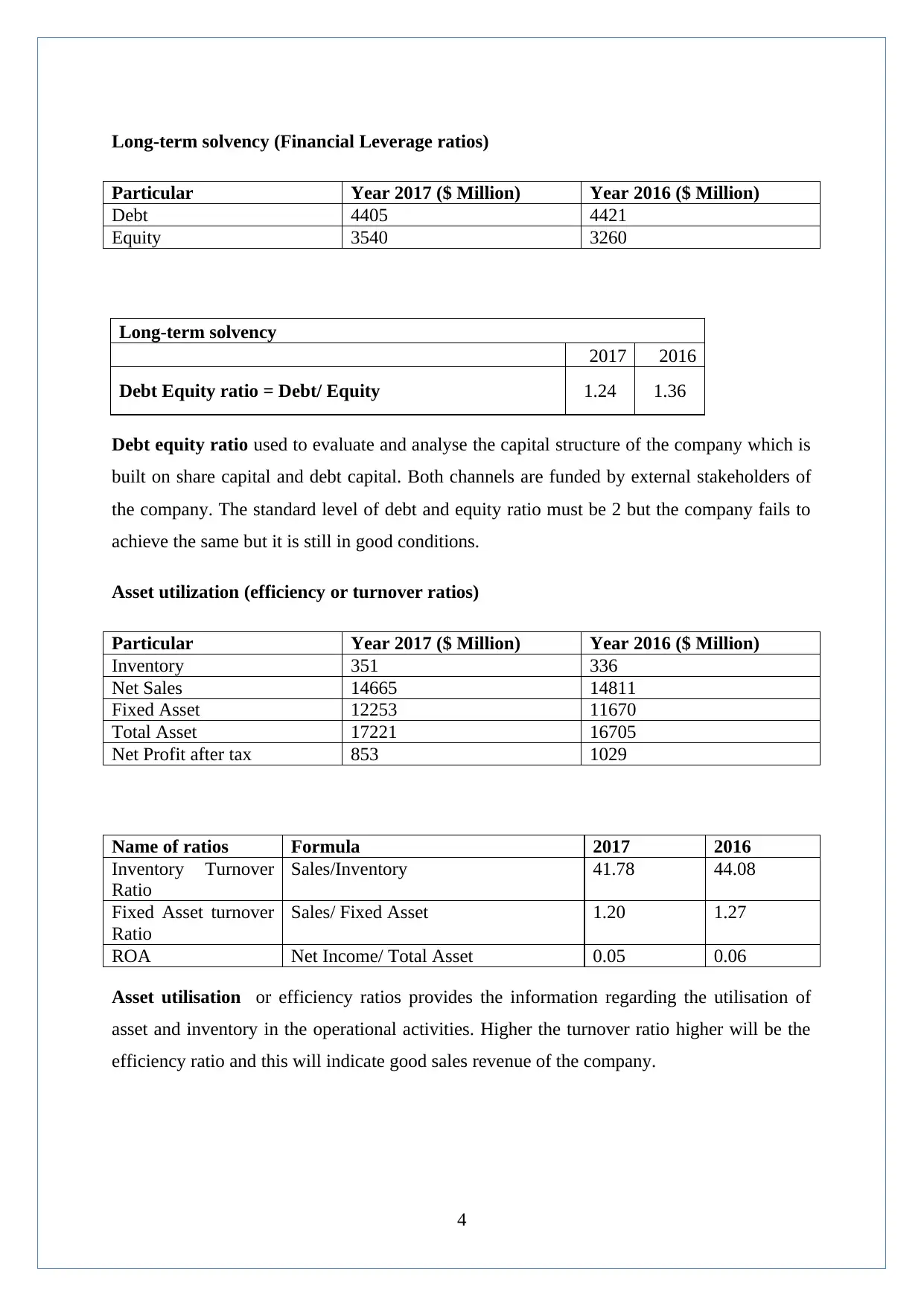
Long-term solvency (Financial Leverage ratios)
Particular Year 2017 ($ Million) Year 2016 ($ Million)
Debt 4405 4421
Equity 3540 3260
Long-term solvency
2017 2016
Debt Equity ratio = Debt/ Equity 1.24 1.36
Debt equity ratio used to evaluate and analyse the capital structure of the company which is
built on share capital and debt capital. Both channels are funded by external stakeholders of
the company. The standard level of debt and equity ratio must be 2 but the company fails to
achieve the same but it is still in good conditions.
Asset utilization (efficiency or turnover ratios)
Particular Year 2017 ($ Million) Year 2016 ($ Million)
Inventory 351 336
Net Sales 14665 14811
Fixed Asset 12253 11670
Total Asset 17221 16705
Net Profit after tax 853 1029
Name of ratios Formula 2017 2016
Inventory Turnover
Ratio
Sales/Inventory 41.78 44.08
Fixed Asset turnover
Ratio
Sales/ Fixed Asset 1.20 1.27
ROA Net Income/ Total Asset 0.05 0.06
Asset utilisation or efficiency ratios provides the information regarding the utilisation of
asset and inventory in the operational activities. Higher the turnover ratio higher will be the
efficiency ratio and this will indicate good sales revenue of the company.
4
Particular Year 2017 ($ Million) Year 2016 ($ Million)
Debt 4405 4421
Equity 3540 3260
Long-term solvency
2017 2016
Debt Equity ratio = Debt/ Equity 1.24 1.36
Debt equity ratio used to evaluate and analyse the capital structure of the company which is
built on share capital and debt capital. Both channels are funded by external stakeholders of
the company. The standard level of debt and equity ratio must be 2 but the company fails to
achieve the same but it is still in good conditions.
Asset utilization (efficiency or turnover ratios)
Particular Year 2017 ($ Million) Year 2016 ($ Million)
Inventory 351 336
Net Sales 14665 14811
Fixed Asset 12253 11670
Total Asset 17221 16705
Net Profit after tax 853 1029
Name of ratios Formula 2017 2016
Inventory Turnover
Ratio
Sales/Inventory 41.78 44.08
Fixed Asset turnover
Ratio
Sales/ Fixed Asset 1.20 1.27
ROA Net Income/ Total Asset 0.05 0.06
Asset utilisation or efficiency ratios provides the information regarding the utilisation of
asset and inventory in the operational activities. Higher the turnover ratio higher will be the
efficiency ratio and this will indicate good sales revenue of the company.
4
Paraphrase This Document
Need a fresh take? Get an instant paraphrase of this document with our AI Paraphraser
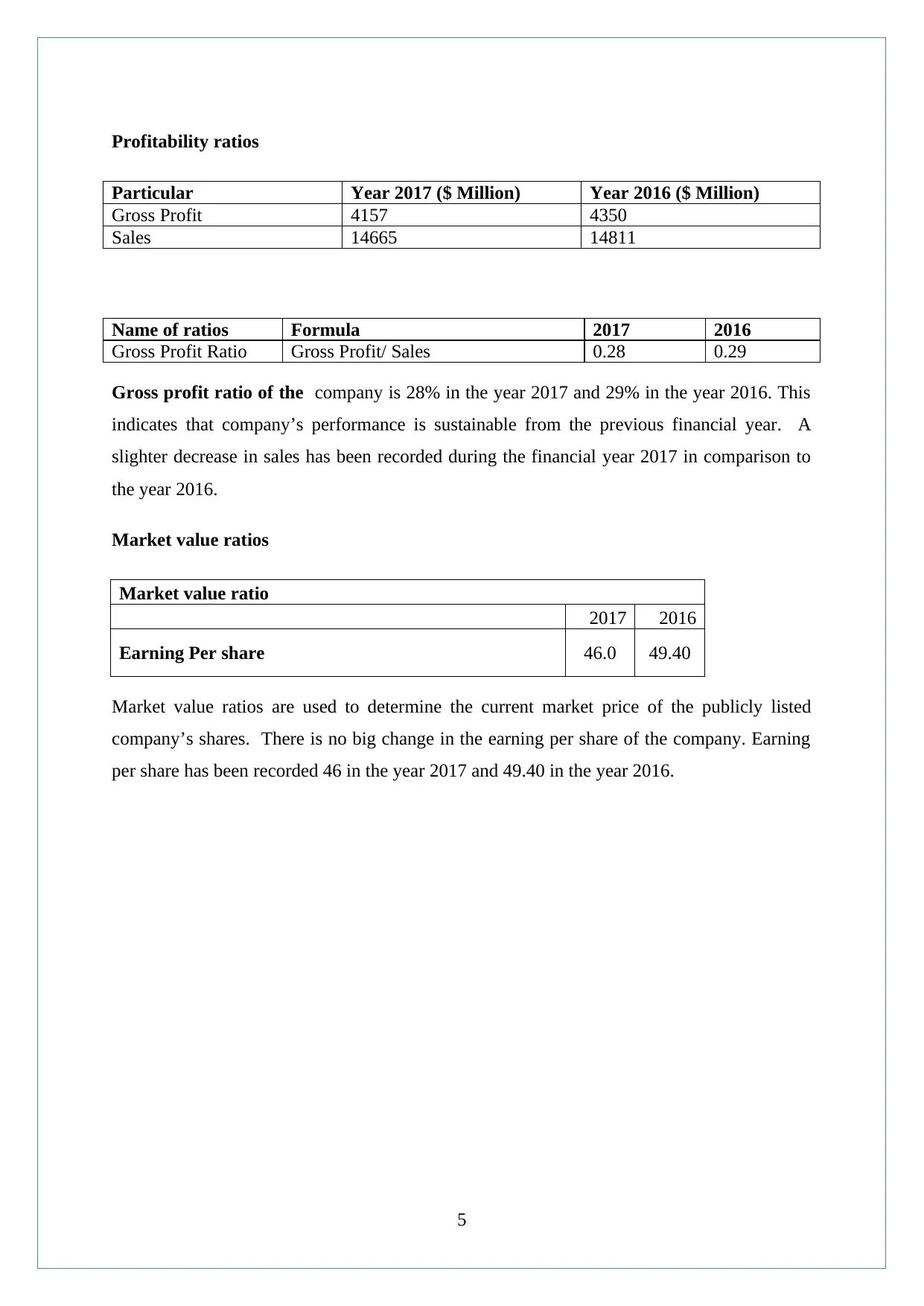
Profitability ratios
Particular Year 2017 ($ Million) Year 2016 ($ Million)
Gross Profit 4157 4350
Sales 14665 14811
Name of ratios Formula 2017 2016
Gross Profit Ratio Gross Profit/ Sales 0.28 0.29
Gross profit ratio of the company is 28% in the year 2017 and 29% in the year 2016. This
indicates that company’s performance is sustainable from the previous financial year. A
slighter decrease in sales has been recorded during the financial year 2017 in comparison to
the year 2016.
Market value ratios
Market value ratio
2017 2016
Earning Per share 46.0 49.40
Market value ratios are used to determine the current market price of the publicly listed
company’s shares. There is no big change in the earning per share of the company. Earning
per share has been recorded 46 in the year 2017 and 49.40 in the year 2016.
5
Particular Year 2017 ($ Million) Year 2016 ($ Million)
Gross Profit 4157 4350
Sales 14665 14811
Name of ratios Formula 2017 2016
Gross Profit Ratio Gross Profit/ Sales 0.28 0.29
Gross profit ratio of the company is 28% in the year 2017 and 29% in the year 2016. This
indicates that company’s performance is sustainable from the previous financial year. A
slighter decrease in sales has been recorded during the financial year 2017 in comparison to
the year 2016.
Market value ratios
Market value ratio
2017 2016
Earning Per share 46.0 49.40
Market value ratios are used to determine the current market price of the publicly listed
company’s shares. There is no big change in the earning per share of the company. Earning
per share has been recorded 46 in the year 2017 and 49.40 in the year 2016.
5
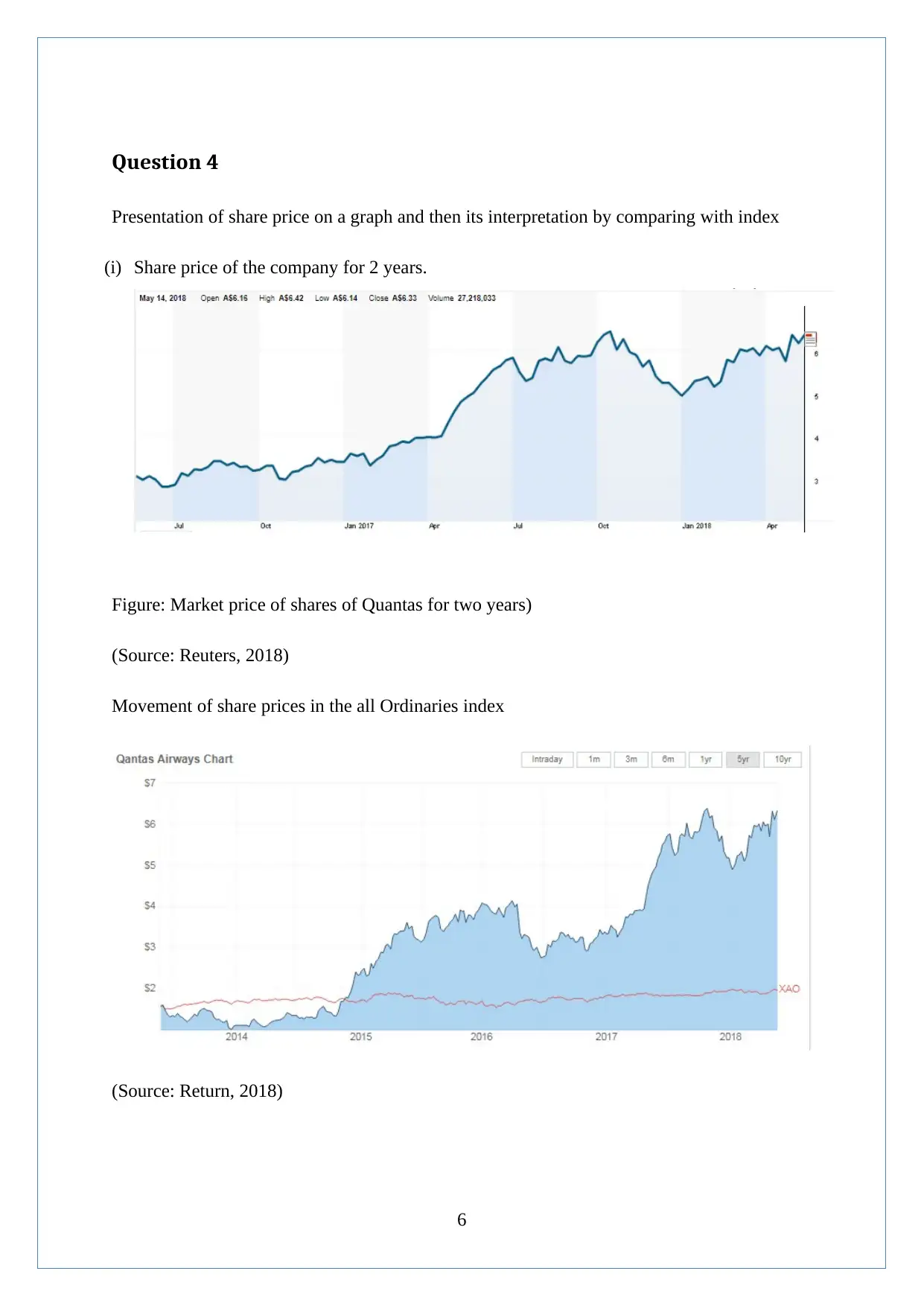
Question 4
Presentation of share price on a graph and then its interpretation by comparing with index
(i) Share price of the company for 2 years.
Figure: Market price of shares of Quantas for two years)
(Source: Reuters, 2018)
Movement of share prices in the all Ordinaries index
(Source: Return, 2018)
6
Presentation of share price on a graph and then its interpretation by comparing with index
(i) Share price of the company for 2 years.
Figure: Market price of shares of Quantas for two years)
(Source: Reuters, 2018)
Movement of share prices in the all Ordinaries index
(Source: Return, 2018)
6
⊘ This is a preview!⊘
Do you want full access?
Subscribe today to unlock all pages.

Trusted by 1+ million students worldwide
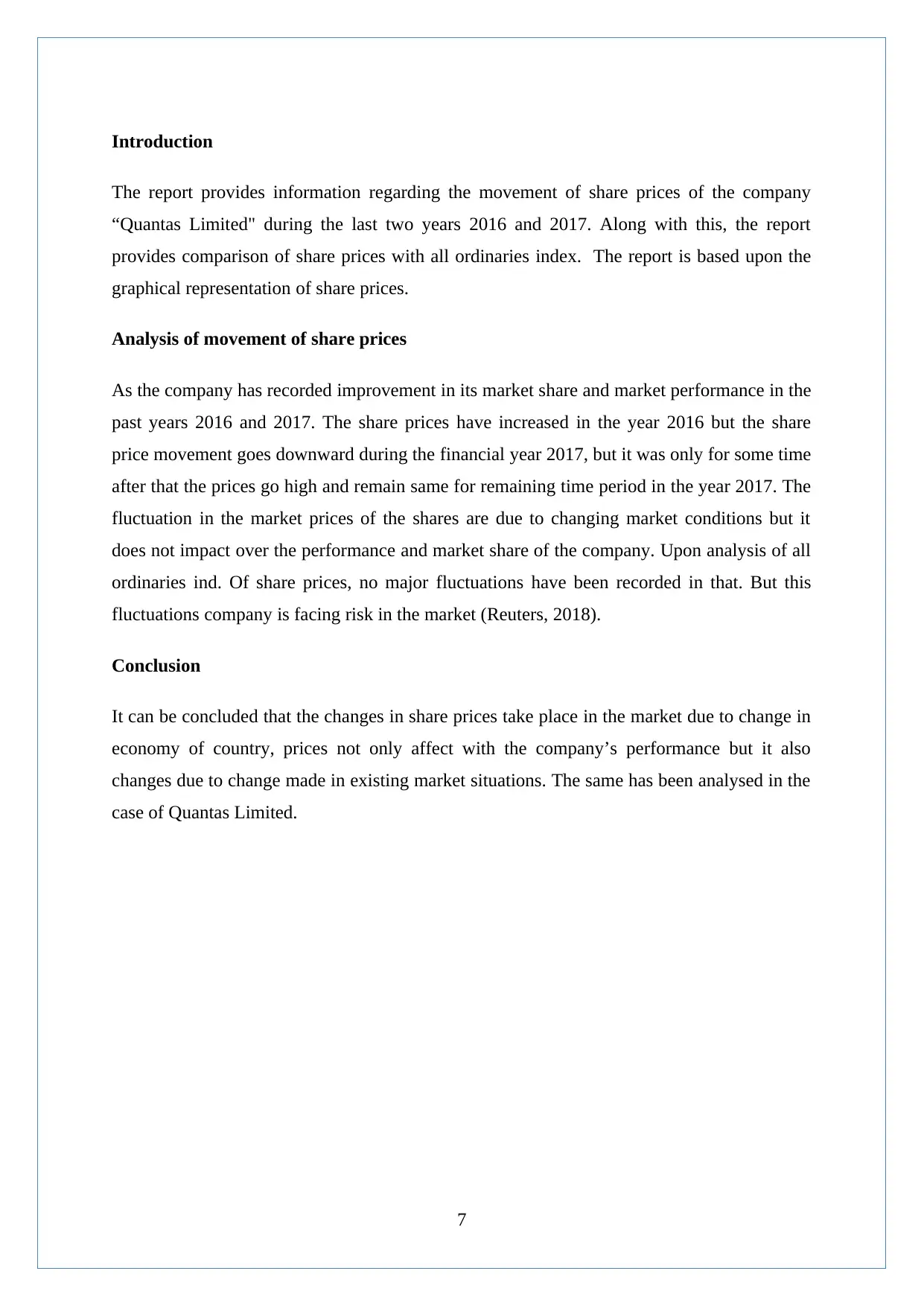
Introduction
The report provides information regarding the movement of share prices of the company
“Quantas Limited" during the last two years 2016 and 2017. Along with this, the report
provides comparison of share prices with all ordinaries index. The report is based upon the
graphical representation of share prices.
Analysis of movement of share prices
As the company has recorded improvement in its market share and market performance in the
past years 2016 and 2017. The share prices have increased in the year 2016 but the share
price movement goes downward during the financial year 2017, but it was only for some time
after that the prices go high and remain same for remaining time period in the year 2017. The
fluctuation in the market prices of the shares are due to changing market conditions but it
does not impact over the performance and market share of the company. Upon analysis of all
ordinaries ind. Of share prices, no major fluctuations have been recorded in that. But this
fluctuations company is facing risk in the market (Reuters, 2018).
Conclusion
It can be concluded that the changes in share prices take place in the market due to change in
economy of country, prices not only affect with the company’s performance but it also
changes due to change made in existing market situations. The same has been analysed in the
case of Quantas Limited.
7
The report provides information regarding the movement of share prices of the company
“Quantas Limited" during the last two years 2016 and 2017. Along with this, the report
provides comparison of share prices with all ordinaries index. The report is based upon the
graphical representation of share prices.
Analysis of movement of share prices
As the company has recorded improvement in its market share and market performance in the
past years 2016 and 2017. The share prices have increased in the year 2016 but the share
price movement goes downward during the financial year 2017, but it was only for some time
after that the prices go high and remain same for remaining time period in the year 2017. The
fluctuation in the market prices of the shares are due to changing market conditions but it
does not impact over the performance and market share of the company. Upon analysis of all
ordinaries ind. Of share prices, no major fluctuations have been recorded in that. But this
fluctuations company is facing risk in the market (Reuters, 2018).
Conclusion
It can be concluded that the changes in share prices take place in the market due to change in
economy of country, prices not only affect with the company’s performance but it also
changes due to change made in existing market situations. The same has been analysed in the
case of Quantas Limited.
7
Paraphrase This Document
Need a fresh take? Get an instant paraphrase of this document with our AI Paraphraser
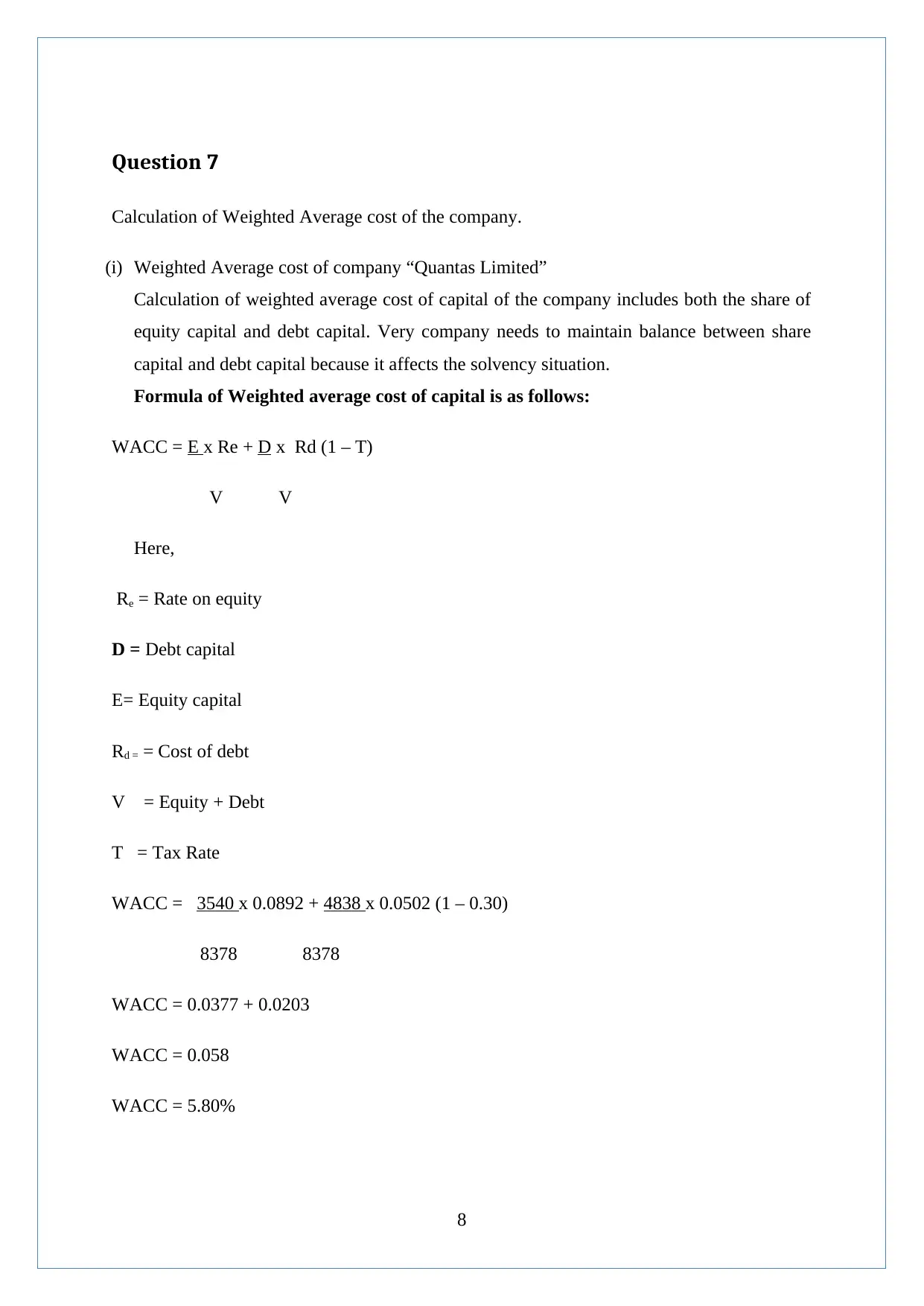
Question 7
Calculation of Weighted Average cost of the company.
(i) Weighted Average cost of company “Quantas Limited”
Calculation of weighted average cost of capital of the company includes both the share of
equity capital and debt capital. Very company needs to maintain balance between share
capital and debt capital because it affects the solvency situation.
Formula of Weighted average cost of capital is as follows:
WACC = E x Re + D x Rd (1 – T)
V V
Here,
Re = Rate on equity
D = Debt capital
E= Equity capital
Rd = = Cost of debt
V = Equity + Debt
T = Tax Rate
WACC = 3540 x 0.0892 + 4838 x 0.0502 (1 – 0.30)
8378 8378
WACC = 0.0377 + 0.0203
WACC = 0.058
WACC = 5.80%
8
Calculation of Weighted Average cost of the company.
(i) Weighted Average cost of company “Quantas Limited”
Calculation of weighted average cost of capital of the company includes both the share of
equity capital and debt capital. Very company needs to maintain balance between share
capital and debt capital because it affects the solvency situation.
Formula of Weighted average cost of capital is as follows:
WACC = E x Re + D x Rd (1 – T)
V V
Here,
Re = Rate on equity
D = Debt capital
E= Equity capital
Rd = = Cost of debt
V = Equity + Debt
T = Tax Rate
WACC = 3540 x 0.0892 + 4838 x 0.0502 (1 – 0.30)
8378 8378
WACC = 0.0377 + 0.0203
WACC = 0.058
WACC = 5.80%
8
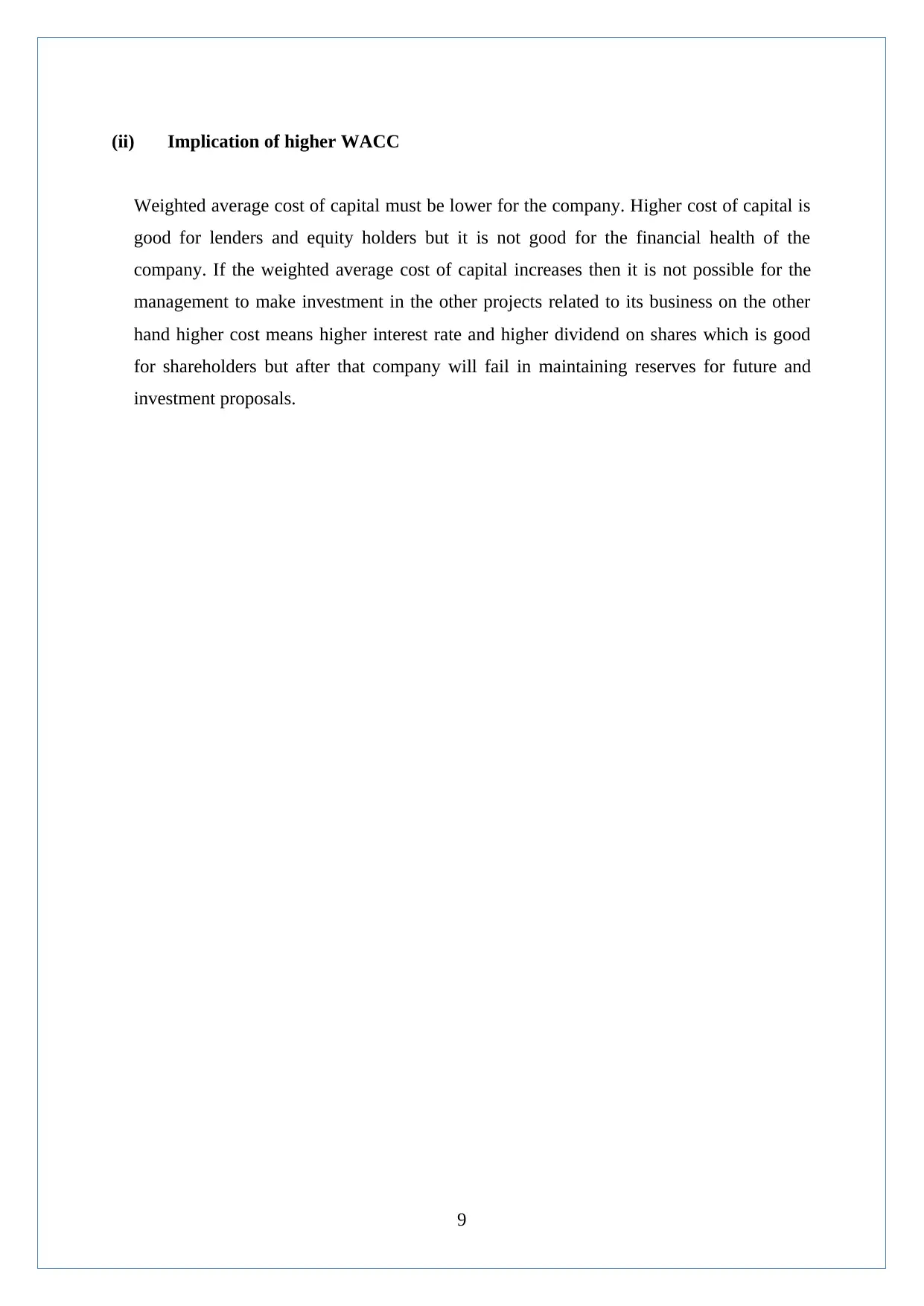
(ii) Implication of higher WACC
Weighted average cost of capital must be lower for the company. Higher cost of capital is
good for lenders and equity holders but it is not good for the financial health of the
company. If the weighted average cost of capital increases then it is not possible for the
management to make investment in the other projects related to its business on the other
hand higher cost means higher interest rate and higher dividend on shares which is good
for shareholders but after that company will fail in maintaining reserves for future and
investment proposals.
9
Weighted average cost of capital must be lower for the company. Higher cost of capital is
good for lenders and equity holders but it is not good for the financial health of the
company. If the weighted average cost of capital increases then it is not possible for the
management to make investment in the other projects related to its business on the other
hand higher cost means higher interest rate and higher dividend on shares which is good
for shareholders but after that company will fail in maintaining reserves for future and
investment proposals.
9
⊘ This is a preview!⊘
Do you want full access?
Subscribe today to unlock all pages.

Trusted by 1+ million students worldwide
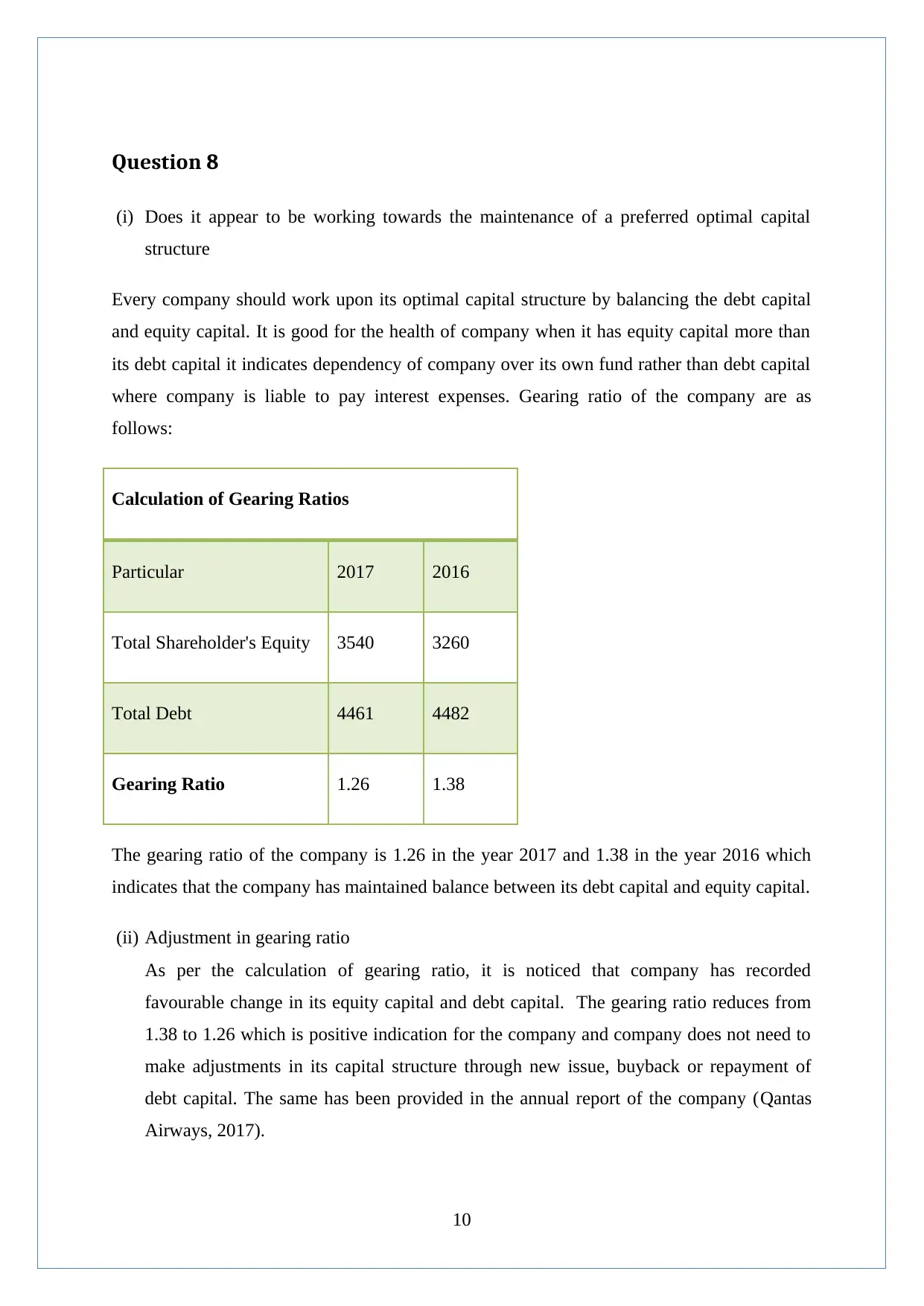
Question 8
(i) Does it appear to be working towards the maintenance of a preferred optimal capital
structure
Every company should work upon its optimal capital structure by balancing the debt capital
and equity capital. It is good for the health of company when it has equity capital more than
its debt capital it indicates dependency of company over its own fund rather than debt capital
where company is liable to pay interest expenses. Gearing ratio of the company are as
follows:
Calculation of Gearing Ratios
Particular 2017 2016
Total Shareholder's Equity 3540 3260
Total Debt 4461 4482
Gearing Ratio 1.26 1.38
The gearing ratio of the company is 1.26 in the year 2017 and 1.38 in the year 2016 which
indicates that the company has maintained balance between its debt capital and equity capital.
(ii) Adjustment in gearing ratio
As per the calculation of gearing ratio, it is noticed that company has recorded
favourable change in its equity capital and debt capital. The gearing ratio reduces from
1.38 to 1.26 which is positive indication for the company and company does not need to
make adjustments in its capital structure through new issue, buyback or repayment of
debt capital. The same has been provided in the annual report of the company (Qantas
Airways, 2017).
10
(i) Does it appear to be working towards the maintenance of a preferred optimal capital
structure
Every company should work upon its optimal capital structure by balancing the debt capital
and equity capital. It is good for the health of company when it has equity capital more than
its debt capital it indicates dependency of company over its own fund rather than debt capital
where company is liable to pay interest expenses. Gearing ratio of the company are as
follows:
Calculation of Gearing Ratios
Particular 2017 2016
Total Shareholder's Equity 3540 3260
Total Debt 4461 4482
Gearing Ratio 1.26 1.38
The gearing ratio of the company is 1.26 in the year 2017 and 1.38 in the year 2016 which
indicates that the company has maintained balance between its debt capital and equity capital.
(ii) Adjustment in gearing ratio
As per the calculation of gearing ratio, it is noticed that company has recorded
favourable change in its equity capital and debt capital. The gearing ratio reduces from
1.38 to 1.26 which is positive indication for the company and company does not need to
make adjustments in its capital structure through new issue, buyback or repayment of
debt capital. The same has been provided in the annual report of the company (Qantas
Airways, 2017).
10
Paraphrase This Document
Need a fresh take? Get an instant paraphrase of this document with our AI Paraphraser
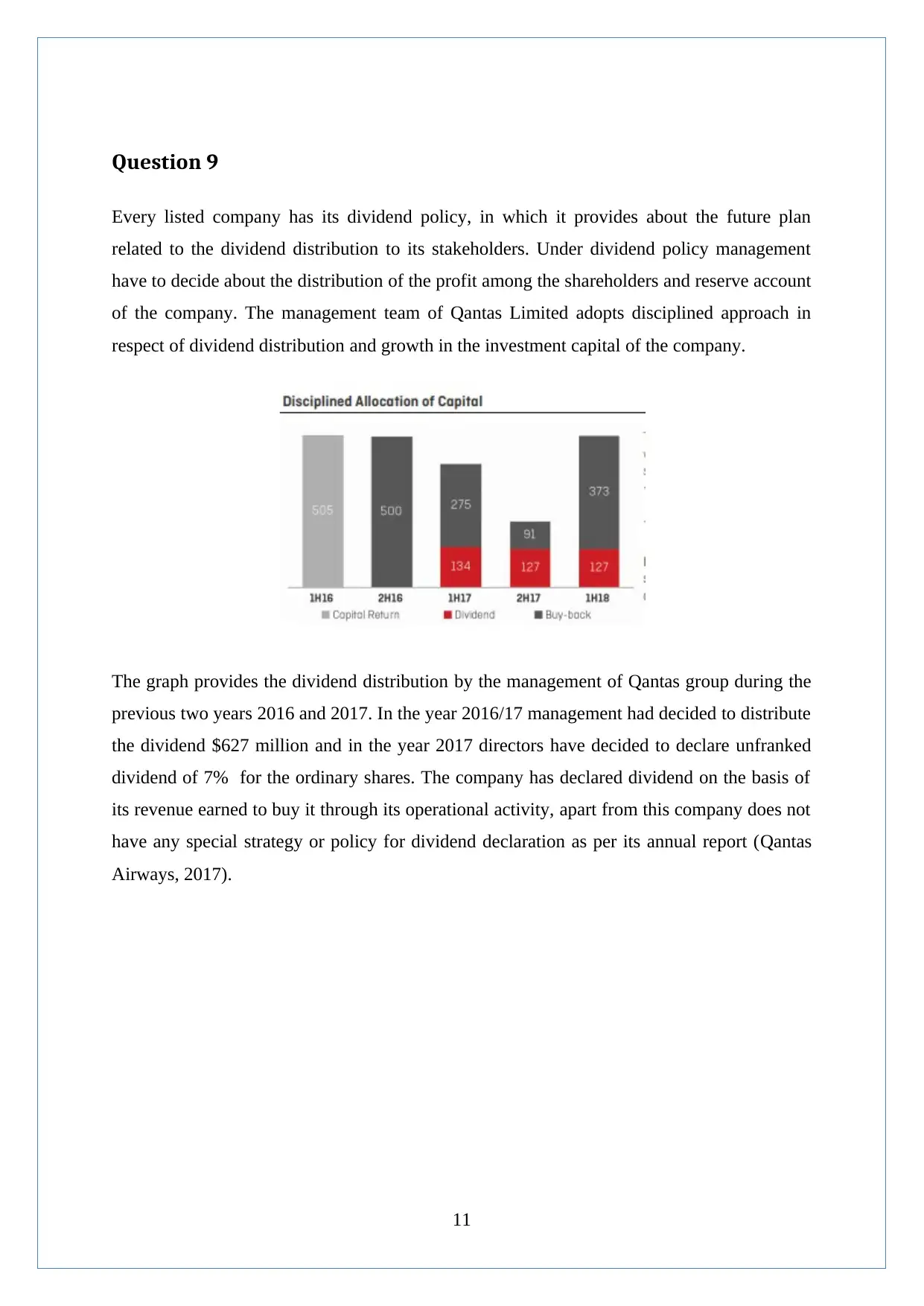
Question 9
Every listed company has its dividend policy, in which it provides about the future plan
related to the dividend distribution to its stakeholders. Under dividend policy management
have to decide about the distribution of the profit among the shareholders and reserve account
of the company. The management team of Qantas Limited adopts disciplined approach in
respect of dividend distribution and growth in the investment capital of the company.
The graph provides the dividend distribution by the management of Qantas group during the
previous two years 2016 and 2017. In the year 2016/17 management had decided to distribute
the dividend $627 million and in the year 2017 directors have decided to declare unfranked
dividend of 7% for the ordinary shares. The company has declared dividend on the basis of
its revenue earned to buy it through its operational activity, apart from this company does not
have any special strategy or policy for dividend declaration as per its annual report (Qantas
Airways, 2017).
11
Every listed company has its dividend policy, in which it provides about the future plan
related to the dividend distribution to its stakeholders. Under dividend policy management
have to decide about the distribution of the profit among the shareholders and reserve account
of the company. The management team of Qantas Limited adopts disciplined approach in
respect of dividend distribution and growth in the investment capital of the company.
The graph provides the dividend distribution by the management of Qantas group during the
previous two years 2016 and 2017. In the year 2016/17 management had decided to distribute
the dividend $627 million and in the year 2017 directors have decided to declare unfranked
dividend of 7% for the ordinary shares. The company has declared dividend on the basis of
its revenue earned to buy it through its operational activity, apart from this company does not
have any special strategy or policy for dividend declaration as per its annual report (Qantas
Airways, 2017).
11
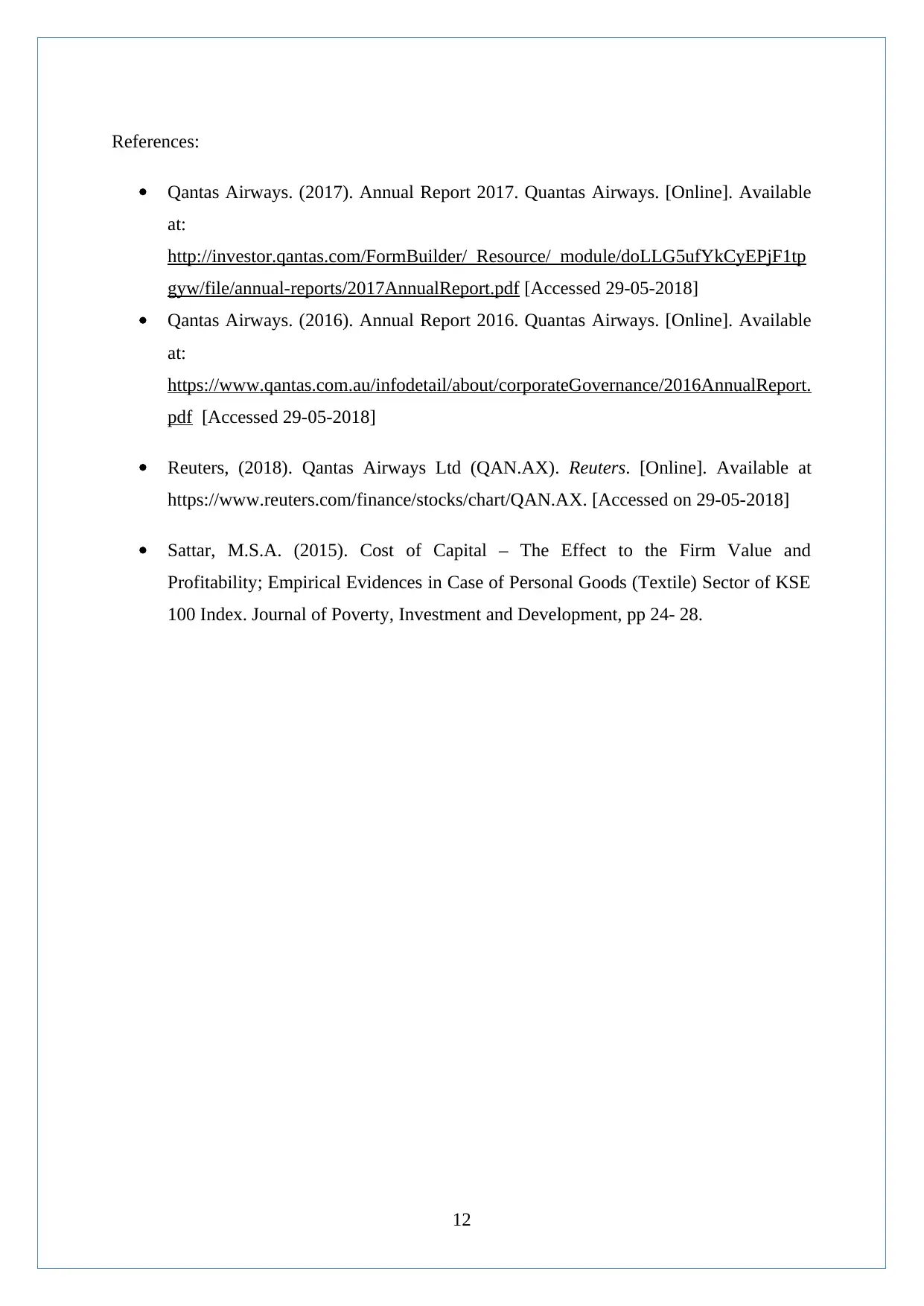
References:
Qantas Airways. (2017). Annual Report 2017. Quantas Airways. [Online]. Available
at:
http://investor.qantas.com/FormBuilder/_Resource/_module/doLLG5ufYkCyEPjF1tp
gyw/file/annual-reports/2017AnnualReport.pdf [Accessed 29-05-2018]
Qantas Airways. (2016). Annual Report 2016. Quantas Airways. [Online]. Available
at:
https://www.qantas.com.au/infodetail/about/corporateGovernance/2016AnnualReport.
pdf [Accessed 29-05-2018]
Reuters, (2018). Qantas Airways Ltd (QAN.AX). Reuters. [Online]. Available at
https://www.reuters.com/finance/stocks/chart/QAN.AX. [Accessed on 29-05-2018]
Sattar, M.S.A. (2015). Cost of Capital – The Effect to the Firm Value and
Profitability; Empirical Evidences in Case of Personal Goods (Textile) Sector of KSE
100 Index. Journal of Poverty, Investment and Development, pp 24- 28.
12
Qantas Airways. (2017). Annual Report 2017. Quantas Airways. [Online]. Available
at:
http://investor.qantas.com/FormBuilder/_Resource/_module/doLLG5ufYkCyEPjF1tp
gyw/file/annual-reports/2017AnnualReport.pdf [Accessed 29-05-2018]
Qantas Airways. (2016). Annual Report 2016. Quantas Airways. [Online]. Available
at:
https://www.qantas.com.au/infodetail/about/corporateGovernance/2016AnnualReport.
pdf [Accessed 29-05-2018]
Reuters, (2018). Qantas Airways Ltd (QAN.AX). Reuters. [Online]. Available at
https://www.reuters.com/finance/stocks/chart/QAN.AX. [Accessed on 29-05-2018]
Sattar, M.S.A. (2015). Cost of Capital – The Effect to the Firm Value and
Profitability; Empirical Evidences in Case of Personal Goods (Textile) Sector of KSE
100 Index. Journal of Poverty, Investment and Development, pp 24- 28.
12
⊘ This is a preview!⊘
Do you want full access?
Subscribe today to unlock all pages.

Trusted by 1+ million students worldwide
1 out of 12
Related Documents
Your All-in-One AI-Powered Toolkit for Academic Success.
+13062052269
info@desklib.com
Available 24*7 on WhatsApp / Email
![[object Object]](/_next/static/media/star-bottom.7253800d.svg)
Unlock your academic potential
Copyright © 2020–2025 A2Z Services. All Rights Reserved. Developed and managed by ZUCOL.





